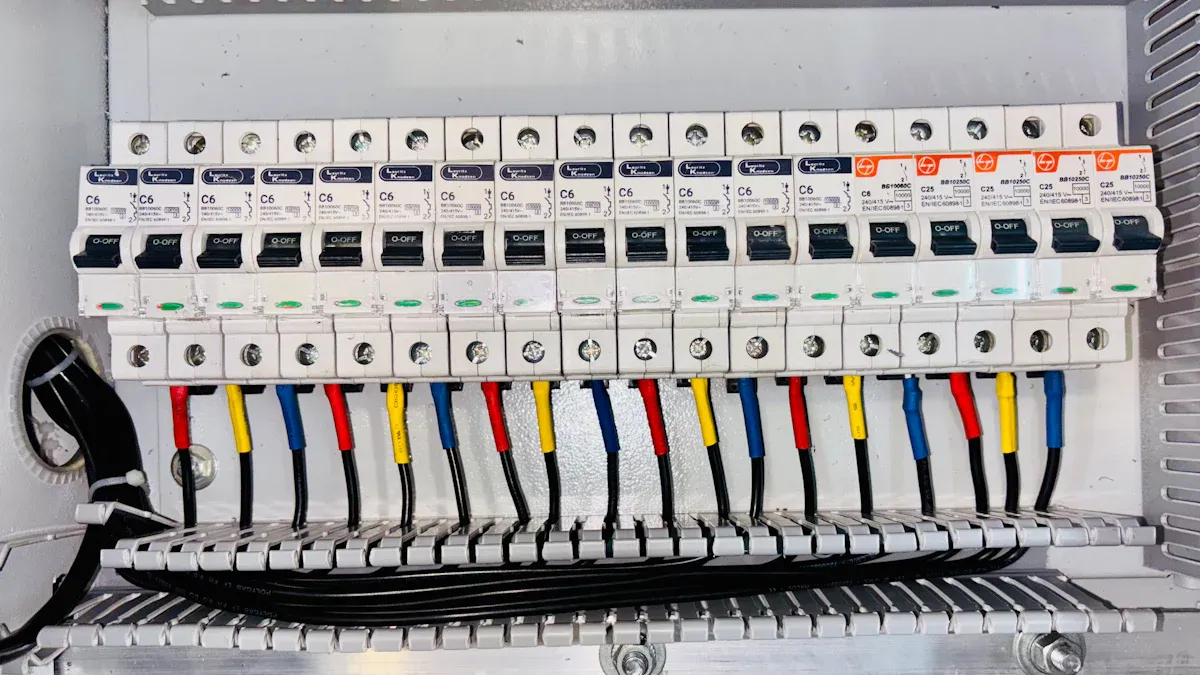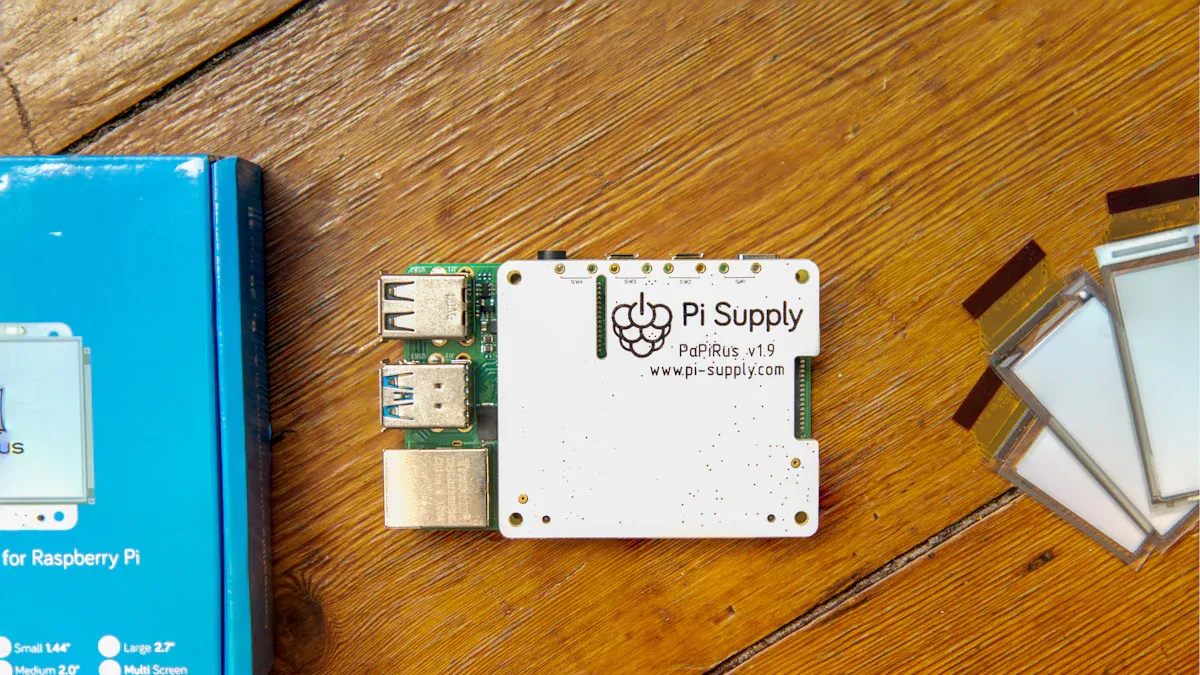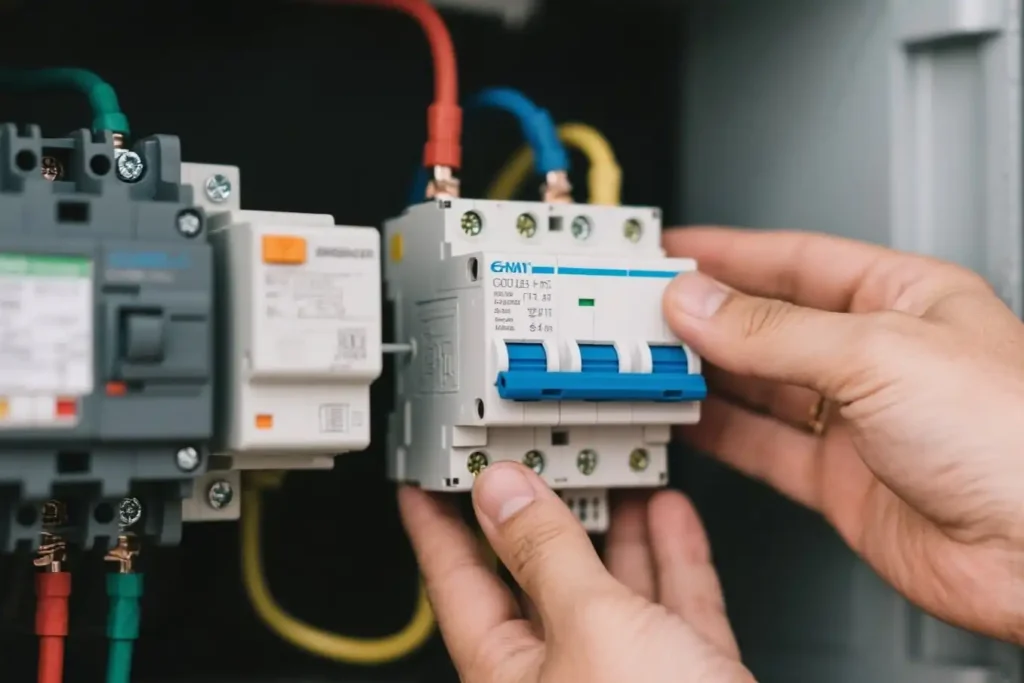A durable miniature circuit breaker is special. It can handle high fault currents safely. It works many times without breaking. Good models can last up to 20 years. They can work for 10,000 to 12,000 cycles. This means you do not need to replace them often. They help protect people from electrical dangers. This makes them a smart choice for homes and businesses. They also help save money.
The table below shows important things that make miniature circuit breakers last long and work well:
| Parameter | Typical Value/Range | Importance for Durability |
|---|---|---|
| Rated Current (In) | 0.5 to 100 A | Handles steady current flow |
| Fault Capacity | Up to 16 kA | Stops high fault currents safely |
| Trip Mechanisms | Thermal and magnetic | Makes sure it trips fast and right |
| Trip-Free Mechanism | Present | Stops unsafe manual override |
Key Takeaways
- Durable miniature circuit breakers keep people and equipment safe. They stop dangerous electrical currents fast and safely. They work for a long time, often 10,000 to 20,000 cycles. This means you do not need to replace them often. This also helps save money. Strong materials like flame-resistant plastics make them last longer. Silver contacts help them work well in hard conditions. A trip-free mechanism makes sure the breaker turns off during problems. It works even if someone tries to keep it on. To pick the right breaker, check for good quality signs. Follow safety rules and match the breaker to your system.
What Is a Durable Miniature Circuit Breaker

Definition and Purpose
A durable miniature circuit breaker keeps circuits safe from harm. It stops electricity if there is too much current. This device uses thermal and magnetic trip mechanisms. The thermal part works when there is a slow overload. The magnetic part acts fast during sudden surges or short circuits. These features help stop fires and protect equipment.
Miniature circuit breakers are used in homes, offices, and factories. They fit inside distribution panels to protect wires and devices. Engineers make sure they meet strict rules like IEC 60898, UL 489, and CSA 22.2 No. 5. These rules help the breakers work safely and well. Manufacturers make different tripping curves like B, C, and D. Each curve fits different needs. Curve B is good for lights. Curve D is better for machines that need more current.
A durable miniature circuit breaker usually has:
- Small and strong build for easy setup.
- High breaking capacity, sometimes 10 kA or more.
- Trip-free design to stop unsafe manual override.
- Certifications like UL Listed and CE Marked for safety.
Key Benefits
A durable miniature circuit breaker gives many benefits:
- Long Service Life: Many models last 10,000 to 20,000 cycles. This means you do not need to replace them often.
- Reliable Protection: It protects against overloads and short circuits. This keeps people and equipment safe.
- Clear Status Indication: Features like a Contact Position Indicator (CPI) show if it is on or off.
- Flexible Application: It works in AC and DC systems. It fits many types of panels.
- Easy Maintenance: Simple wiring and checks help keep it working well.
| Specification | Value |
|---|---|
| Rated Current | 1A to 63A |
| Rated Voltage | AC 230V/400V |
| Breaking Capacity | 3kA, 4.5kA, 6kA |
| Number of Poles | 1P to 4P |
| Mechanical Life | 20,000 cycles |
| Electrical Life | 10,000 cycles |
Experts test these breakers for quality and safety. They check for durability, stability, and safety rules. This careful testing makes sure a durable miniature circuit breaker will protect for many years.
Key Features

Robust Housing
A durable miniature circuit breaker has a tough outside shell. Makers use strong thermoplastics for the body. These plastics can handle heat and last a long time. Some, like the ARM3 series, use special nylon PA66. This nylon does not have halogens and is flame resistant. It can handle hot and cold, sunlight, and getting old. The nylon also insulates well and keeps its shape.
- Good thermoplastics help the breaker last longer.
- Copper contacts help electricity flow and make it stronger.
- Rules like IEC and UL make sure the breaker is tested well.
- Strong design and materials make the breaker work better.
The plastics must handle shaking, hits, and changes in heat. Polyamide is used a lot because it stays strong under stress. These things help the breaker work safely in hard places.
Note: QPQ salt bath treatments help metal parts last longer. They stop rust and wear, so the breaker works for more years.
High Breaking Capacity
A durable miniature circuit breaker must stop big fault currents. Breaking capacity is the most current it can safely stop. Many good breakers can stop 10,000 amperes (10 kA). Some can stop up to 20 kA for special jobs. This means the breaker can protect places with strong fault currents, like factories.
- 10,000 A breaking capacity is common in big buildings.
- Some, like the Schneider Electric Multi9 C60N, have 10 kA at 240 V AC and 15 kA at 72 V DC.
- Breaking capacity can be from 3 kA to 20 kA.
- Higher numbers mean better safety during big faults.
Tests show a 10 kA breaker stops dangerous currents fast. In one test, the arc voltage went over 1800 V and lasted only 5 milliseconds. This quick action keeps the breaker and equipment safe. 10 kA breakers last longer and work better than 6 kA models.
Trip-Free Mechanism
A trip-free mechanism is very important for safety. It makes sure the breaker trips even if someone holds the switch on. This stops people from making it unsafe. The breaker will always turn off the circuit during a fault. This keeps people and equipment safe.
- The trip-free design stops unsafe use by hand.
- It makes sure the breaker works right during problems.
- This adds more safety and trust.
Thermal-Magnetic Protection
Thermal-magnetic protection uses two ways to trip. The thermal part has a bimetal strip. If too much current flows for a while, the strip bends and trips the breaker. The magnetic part has a coil that acts fast during a sudden surge or short circuit.
| Feature | Description | Performance Benchmark Aspect |
|---|---|---|
| Thermal Trip Mechanism | Bimetal strip bends when hot and trips the breaker. | The curve is slow but steady, good for high-inrush current. |
| Magnetic Trip Mechanism | Coil trips the breaker almost right away during a short. | The curve is straight, showing fast action for big faults. |
| Trip Curves | Shows how fast the breaker trips at different currents. | Helps know what to expect during faults for safety. |
| Clearing Time | Breaker trips faster with higher current because of its design. | Shows it can disconnect quickly to keep things safe. |
This system helps the breaker trip right for both slow and fast problems. The breaker turns off quickly to keep people and equipment safe.
Long Service Life
A durable miniature circuit breaker should last many years. Most wear comes from arcs burning the contacts. Experts use tests and computers to see how long a breaker will last. They check arc currents and how the contacts wear down. As contacts wear, the breaker’s life gets shorter, but good design helps it last longer.
- Most breakers last 10-15 years if cared for.
- Industrial ones last longer because they are made for hard work.
- Good care includes:
- Cleaning dust from panels.
- Testing the trip feature often.
- Tightening wires to stop overheating.
- Watching the load to stop overloading.
- Having electricians check for problems early.
If a breaker trips a lot, looks damaged, or makes odd sounds, it may need replacing. The quality, where it is used, and how often it trips all matter. Using it right and checking it often helps it last longer and keeps things safe.
Selection Tips for Durable Miniature Circuit Breaker
Quality Indicators
When picking a durable miniature circuit breaker, look for signs of good quality. These signs help you know if the breaker will work well for a long time.
- The bimetal sheet inside should be strong and steady. If it is not, the breaker might trip at the wrong time or not trip at all.
- The breaker needs to stop short circuits and arcs fast. If it cannot, the case and inside parts can get damaged.
- The outside shell should be thick and tough. If it is weak, it can break during problems.
- Rivets should be sturdy and made from good stuff. Weak rivets can break when the breaker faces arc energy.
- Contacts should have silver in them. If they are just copper, they burn faster and do not last as long.
- Inside wires and welds must be tight and solid. Thin wires or bad welds can make the breaker overheat and stop working.
Tip: Always read the product details or ask the seller about these things before you buy.
Standards Compliance
A durable miniature circuit breaker should follow strict rules. The most important rules are IEC 60898-1 and IEC 60947-2. These rules test if the breaker can stop big currents and still work after problems. IEC 60898-1 checks how much current the breaker can stop. IEC 60947-2 tests even higher limits. The difference between these test results shows how strong the breaker is. Bigger differences mean the breaker is tougher. If the breaker has these certifications, it means it passed hard tests and will last longer.
Application Matching
Not every breaker is right for every job. You should pick a breaker that fits your system.
- For homes, a 6 kA breaker is usually enough. It follows safety rules and keeps people safe from shocks and fires.
- For factories or places with lots of fault current, pick a breaker with higher breaking capacity, like 10 kA or more.
- Look for things like selective tripping and special trip features. These help the breaker work better in tricky systems.
- Always check if the breaker passed quality checks and has the right certificates.
A durable miniature circuit breaker with the right features will keep people and equipment safe for many years.
A durable miniature circuit breaker has a tough outside, can stop big currents, and trips when needed. Picking the right one keeps people safe and saves money over time. To find the best breaker, users should do these things: 1. Make sure it is built well and wires are tight. 2. Check if it follows rules like IEC 60898-1. 3. Look for rust, damage, or loose pieces. 4. Test if it trips off like it should. 5. Choose one that fits the system’s power and voltage.
Doing regular checks and picking carefully helps keep electrical systems safe and working well.
ONESTOP is a professional manufacturer of durable circuit breakers, offering a variety of models to provide customers with comprehensive electrical solutions
FAQ
What does “breaking capacity” mean for a miniature circuit breaker?
Breaking capacity tells how much fault current the breaker can stop. If the number is higher, the breaker gives better safety. Most strong breakers can stop at least 6 kA. Some can even stop up to 20 kA in factories.
How often should someone check or maintain a miniature circuit breaker?
Experts say you should check breakers once every year. Look for dust, loose wires, or any damage. Checking often helps the breaker last longer and keeps things safe.
Can a miniature circuit breaker be used for both AC and DC circuits?
Many new miniature circuit breakers work with both AC and DC. Always read the product label or datasheet first. The maker will show the right voltage and current for each type.
What is a trip-free mechanism and why is it important?
A trip-free mechanism makes the breaker trip during a fault. It works even if someone tries to keep the switch on. This keeps people and equipment safe from electrical dangers.
The following information may be of interest to you
Can lightning trip a circuit breaker
Understanding a and b Contacts in Circuit Breakers
What breaker size do well pumps typically need
What Should You Know About QO Circuit Breakers
How to Wire a Double Pole 20 Amp Breaker Safely




